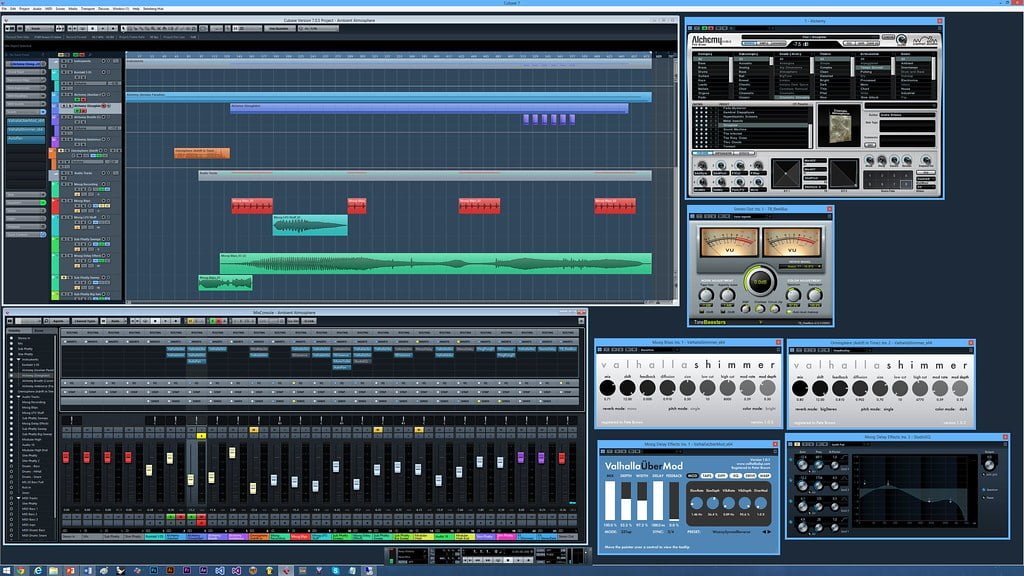Orchestral Virtual Instruments: Adding Realism to MIDI-Based Arrangements
In crafting MIDI-based orchestrations, utilizing orchestral virtual instruments with precision is key to accessing a new level of realism and authenticity in compositions. By intricately assigning unique audio tracks to individual instrument channels and employing strategic reverb effects, one can enhance the depth and quality of the arrangements dramatically. Manipulating MIDI controller parameters with finesse and setting up MIDI sequencing software correctly are essential steps in achieving vibrant orchestral pieces that resonate with emotion and lifelike qualities. These techniques, combined with collaborative efforts with experienced musicians, can help elevate the overall musical expression and depth, leading to truly resonant compositions.
We are supported by our audience. When you purchase through links on our site, we may earn an affiliate commission, at no extra cost for you. Learn more.
Understanding MIDI Orchestration Techniques
Exploring the intricate world of MIDI orchestration techniques unveils a universe where assigning unique audio tracks to individual instrument channels forms the cornerstone of a realistic arrangement. In the domain of virtual instrument performances, the meticulous organization of individual audio tracks for each instrument channel is vital. This process allows for precise control and manipulation of various elements such as volume, expression, velocity, and modulation through MIDI controllers. By assigning specific audio tracks to each instrument, one can fine-tune the nuances of the performance, enhancing the overall realism of orchestral arrangements.
Moreover, the strategic application of reverb on auxiliary tracks plays an essential role in adding depth and authenticity to MIDI-based orchestral recordings. Properly mapping audio inputs, outputs, and MIDI channels is indispensable for accurate MIDI sequencing. This meticulous attention to detail ensures that every note and articulation is captured with precision, contributing to the lifelike quality of the virtual instrument performances.
In essence, mastering MIDI orchestration techniques involves a delicate balance of technical proficiency and artistic expression. By honing the craft of assigning individual audio tracks, utilizing MIDI controllers, implementing reverb effects, and fine-tuning MIDI data, one can breathe life into virtual instrument performances, creating immersive and realistic orchestral arrangements.
Utilizing Reverb Effects for Realism
To infuse MIDI-based orchestral arrangements with a sense of spatial depth and ambiance, the strategic utilization of reverb effects becomes a powerful tool in enhancing realism. When it comes to creating a lifelike orchestral experience within a digital domain, the application of reverb effects plays an important role. Here are some key points to keep in mind:
- Auxiliary Tracks: By setting up auxiliary tracks in your digital audio workstation, you can apply different levels of reverb to individual instruments. This technique helps in creating a more realistic sense of space and distance within the arrangement.
- Customized Reverb: Adjusting reverb settings meticulously allows you to simulate various room environments in your MIDI recordings. Whether you aim for a small, intimate concert hall or a vast cathedral, customized reverb settings can transport your audience to different sonic landscapes.
- Individual Audio Channels: Utilizing separate audio channels for each instrument enables you to apply customized reverb effects tailored to specific instruments. This level of detail enhances the authenticity of the orchestral composition and elevates the overall quality of the arrangement.
Manipulating MIDI Controller Parameters
When exploring MIDI controller parameters, I find that dynamic adjustments play a pivotal role in infusing life into virtual instruments. By modulating expression and velocity, I can create a more authentic musical performance. Incorporating these techniques elevates the realism and emotional depth of MIDI arrangements.
MIDI Controller Dynamics
Enhancing the realism of virtual orchestral arrangements requires skillfully manipulating MIDI controller dynamics to breathe life into digital performances.
- Adjusting volume levels with precision control faders in MIDI software shapes instrument dynamics effectively.
- Utilizing expression, velocity, and modulation controllers offers detailed articulation and phrasing control for MIDI instruments.
- Fine-tuning controller parameters within the sample library’s Essential window is pivotal for achieving nuanced and human-like musical performances.
These actions help transform a flat MIDI-based arrangement into a vibrant and expressive orchestral piece, adding depth and emotion to the music. By mastering MIDI controller dynamics, one can infuse virtual instruments with the subtle nuances and dynamics characteristic of live instrumental performances.
Expressive Modulation Techniques
Implementing essential modulation techniques through the manipulation of MIDI controller parameters elevates the realism and emotion of virtual orchestral performances. By adjusting volume, expression, velocity, and modulation using MIDI controllers, one can achieve lifelike instrument dynamics. Delving into the sample library’s Advanced window to fine-tune articulation and phrasing enhances the overall musicality of MIDI sequences. Additionally, utilizing specific control faders in the MIDI software allows for nuanced and expressive control over the performance. Attention to detail in manipulating these parameters is vital for infusing human-like nuances into MIDI-based arrangements. The interplay of expression, velocity, and modulation controllers is vital for creating a rich and emotive orchestral sound that captivates listeners with its authenticity.
Setting Up MIDI Sequencing Software Correctly
When establishing MIDI sequencing software, it’s essential to configure the MIDI software correctly to guarantee peak performance. Proper instrument mapping setup allows for precise control over each element in the arrangement, enhancing the realism of the virtual instruments. Assigning expression controllers effectively can elevate the dynamics and articulation of the MIDI instruments, enriching the overall sound palette.
MIDI Software Configuration
Traversing through the intricate web of MIDI software configuration demands meticulous attention to detail and strategic planning to optimize orchestral virtual instruments for realistic MIDI arrangements.
- Utilize popular DAWs like Pro Tools, Logic, or Cubase for seamless MIDI sequencing.
- Create distinct audio tracks for each MIDI channel to enhance instrument control.
- Assign specific audio outputs within the sample library plug-in to streamline audio routing.
Mastering the setup of MIDI channels, audio routing, and signal flow within the software is essential for recording flawless orchestral performances. By correctly configuring these elements, your MIDI-based arrangements will resonate with authentic orchestral beauty.
Instrument Mapping Setup
Mastering the complexities of instrument mapping setup in MIDI sequencing software requires careful attention to detail and strategic planning to enhance the control and integration of virtual instruments effectively. In the software, create individual audio tracks for each MIDI channel to manage instruments efficiently. Assign audio outputs for each instrument channel in the sample library plug-in to guarantee seamless integration. Establish audio buses between output channels in the plug-in and DAW for streamlined routing and processing. Accurate mapping of audio inputs, outputs, and MIDI channels is essential for precise recording and playback. Setting up MIDI sequencing software correctly guarantees smooth operation and provides optimal control over virtual instruments, leading to more realistic and engaging musical arrangements.
Expression Controller Assignment
Incorporating expression controllers in MIDI sequencing software elevates the realism and dynamics of virtual instruments, enriching musical arrangements with nuanced control over volume, articulation, and dynamics.
- Assigning expression controllers allows for precise articulation adjustments.
- Using MIDI controllers like modulation enhances the realism of orchestral sounds.
- Fine-tuning sample library parameters can notably improve the nuanced phrasing of virtual instruments.
Seeking Feedback From Experienced Musicians
Engaging with seasoned musicians for feedback on MIDI orchestral arrangements can greatly enhance the authenticity and realism of the compositions. When seeking feedback from experienced musicians, their expertise in instrument articulations, phrasing, and dynamics can provide invaluable insights for achieving more lifelike MIDI performances. These musicians can pinpoint areas in the MIDI compositions that may sound artificial or lack realism, guiding you on how to infuse more musical expression into your arrangements.
Collaborating with professionals not only helps in refining the nuances of MIDI orchestration but also leads to improvements in MIDI sequencing techniques. By incorporating the feedback from these musicians, you can elevate the overall quality and authenticity of your MIDI-based orchestral arrangements. Their input can enhance the depth and richness of the music, making it more engaging and emotionally resonant for the listeners.
Enhancing Brass and Wind Instrument Writing
To elevate the authenticity of MIDI orchestral arrangements, optimizing the writing for brass and wind instruments is vital. When focusing on enhancing brass instruments like the French horn and wind instruments such as the flute, oboe, clarinet, and bassoon in MIDI compositions, attention to detail is essential for achieving realism. Here are some key considerations to keep in mind:
- Utilize CD-ROM sound libraries: These libraries offer a wide range of performance variations for brass instruments, allowing for nuanced articulations and dynamics that contribute to a lifelike sound in MIDI orchestrations.
- Capture the nuances: Realistic wind instrument writing in MIDI necessitates using multiple samples per note to capture subtleties like breath control and specific articulations, ensuring a more authentic performance.
- Blend instruments effectively: Combining flute, oboe, clarinet, bassoon, and French horn in thoughtful arrangements can create rich chord textures and harmonies in MIDI wind sections, adding depth and complexity to the overall sound.







